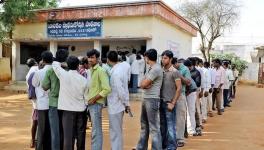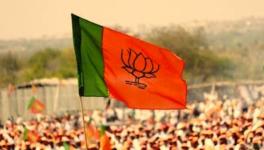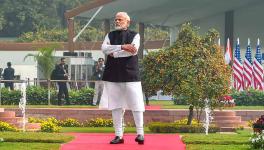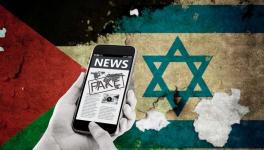Community-Based Mapping of Covid: Nothing Official About it
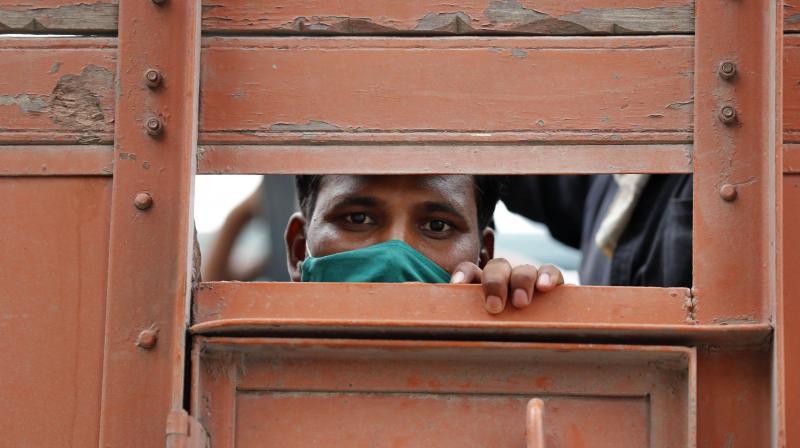
Image Courtesy: AP
“Move for community-based mapping of coronavirus?” a recent news item in a prestigious daily asked, getting tongues wagging about “closed-door meetings at the highest level”, though no “official” decision had been taken in them. The Ministry of Health declared that any such news is “baseless, incorrect and irresponsible”. Lav Agarwal, the top bureaucrat in the ministry—who interacts with the media on Covid-related developments—called such news reports “...very irresponsible”. “The virus does not see people’s caste, creed or religion,” he said, quoting the Supreme Court’s directions on controlling non-factual or fake news.
No doubt the official clarification has many heaving sighs of relief.
The relief is understandable, because it was only last month—when the Novel Coronavirus pandemic had started taking a toll—that Muslims were being stigmatised as “super-spreaders” of the disease.
Taking a grim view of the situation, in its press conference on 6 April, the World Health Organisation had given the Indian government some simple advice. The WHO said, in response to an India-specific question, that countries should not profile Covid-19 infections in religious, racial or ethnic terms. The WHO Emergency Programme Director Mike Ryan also underlined that every positive case should be considered a victim.
What was the context of this simple advice?
In the early days of April, a flurry of fake news had started clogging the internet in India, targeting Muslims as super-spreaders of the disease, thanks to the the ill-advised congregation of Tablighi Jamaat at their headquarters in Delhi and subsequent detection of Covid-19 cases among its members. The way the government, inadvertently or not, further helped inflame the issue by claiming that if infections had not been detected among members of the Jamaat, the disease would not have spread in India as quickly or widely. The government also shared the break-up of cases as those detected among the members of the Jamaat and listed the “non-Jamaat” cases separately—a situation for which there is no precedent anywhere.
There followed instances of attacks on hapless Muslims, such as those who sell vegetables and sundry items and calls for their “social boycott” were raised in different parts of the country. There were also reports of suicides as a consequence of these rumours. The suicide of a Muslim youth in Himachal Pradesh’s Una on 5 April for continued stigmatisation and social boycott had shaken the state, but there were several others.
It is rather troubling to know that a large part of the mainstream media, instead of acting as watchdog of democracy, uncritically accepted the loaded messages and had had no qualms in sharing them with readers and viewers. It even invented a new word for cases detected among the members of the Tablighi Jamaat. It was “Corona Jihad”.
There have been many studies about how the engines of fake news were activated when the Coronavirus came to India. The studies show that a significant section of the mainstream media had itself metamorphosed into “super-spreaders of misinformation’.
A prominent digital news outlet reported findings of its analysis of the news coverage of Covid-19 as follows: We find that news sources ranging from the less widely consumed regional digital news to the heavily engaged with national news, all have been complicit in spreading misinformation. The digital outlet also shared screenshots of news channels including ANI, TOI Kochi, TV9, Global Times, OpIndia and News18, which it said showed them all “participating in the circulation of misinformation”.
So it was evident from the beginning of April that “India has managed to turn even a global, devastating public health emergency into an opportunity to vilify Muslims”, as another news outlet stated. It also said, that this amounted to weaponising “prejudice against Muslims in an effort to build a majoritarian Hindu votebank that shuns older Indian ideas of secularism and tolerance.”
The leading media outlets elsewhere in the world also reported and commented on how Covid-19 had inspired Islamophobia in India. The silence at the top among the country’s Executive as this situation unfolded was—to say the least—baffling.
In fact, it took around two more weeks before the Prime Minister—after the aforementioned “simple advice” from the World Health Organisation—to issue a routine-sounding statement on this worrisome situation (on 19 April).
“Covid-19 does not see race, religion, colour, caste, creed, language or borders before striking,” Modi declared. “Our response and conduct thereafter should attach primacy to unity and brotherhood,” he said.
The above statement is the first of its kind from the Prime Minister, and it was natural for people to wonder why it took him so long to issue such a simple statement. After all, people know that all elected leaders have taken an oath to defend the Constitution, including the Prime Minister.
Looking back, it is not difficult to discern the manner in which the Tablighi Jamaat was singled out and targeted for its unwise decision to continue with its congregations in Delhi. This targeting was only possible if the media and others first glossed over the simple fact that if the central government had not wanted the said conference could not have been held.
Much has been written on it, but it would be useful to remind that the media was very selective in targeting Jamaat members in those days. Remember, while the congregation at its markaz or headquarters had ended on 15 March, many participants had not left the premises as no lockdown had been announced by the Centre. In fact, a lockdown was imposed only on 24 March—more than a week later. It is also a fact that the media had skilfully overlooked all other transgressions, except those that may have been made by the Tablighi members. For instance, the Tirumala Tirupati Devasthanams trust, which operates several temples in and around Tirupati, and hosts over 40,000 daily visitors, only closed its doors to pilgrims and tourists on 19 March. Nor did these news reports mention that on 24 March, barely 12 hours after the government of India announced a national lockdown, Uttar Pradesh CM Yogi Adityanath also visited a temple along with followers and supporters.
Can it be said today that there is a change in the situation?
Any neutral observer of the Covid-19 situation in the country would notice the tremendous opacity in the functioning of the government when it came to the Tablighi Jamaat and the perpetuation of myths about its alleged role in spreading the disease. Can it be said that the same opacity was reflected when hundreds of Tablighi members who tested negative for Covid-19 were kept under quarantine in Delhi despite having spent more than a month at the quarantine centres? A member of Parliament had to write to the Home Ministry seeking their release.
It is even more baffling to note the fate of a report prepared by a think-tank associated with the Union Home Ministry. The report, on “how to spot and investigate” fake news, “red-flagged the targeting of minorities over the Covid pandemic”. It also mentioned that the alleged audio recording of the Jamaat’s chief making sensational statement was nothing but fake news. This audio has been widely circulated. Now, the investigation into this audio and other facts associated with the Jamaat’s congregation is still ongoing, but what is important is that this 40-page “guide for law enforcement agencies” released by the Bureau of Police Research & Development or BPRD, which contained an important disclosure about the audio, was pulled down from its official website within a day of being posted online. When contacted by the Indian Express newspaper, BPRD spokesperson Jitendra Yadav said, “There are some corrections being made in the booklet. It will be uploaded again after that.”
Importantly, this report had asked law-enforcement agencies to not let their own beliefs interfere in their work. “Watch out for information that confirms your pre-existing beliefs. Review facts before sharing the information. Stories that seem hard to believe are often untrue,” it said.
The report also issued guidelines on forensically-investigating fake news so as to make claims against such items admissible as evidence in court. It suggested that law enforcement agencies use tools such as reverse image search, geo-tagging and geo-fencing, and other methods to improve their investigations into fake news.
As things stand, the government has declared that there would not be any community-based mapping of Covid-19 cases, which is a reassuring claim indeed. But can it be said with confidence that this would end the continuous stigmatisation of its biggest religious minority? Or will such assaults revisit in coming days, repackaged, refurbished and reenergised?
If a pandemic which affects the whole of humanity can be given a communal colour, then you cannot belittle the Right’s ability to turn any crisis into an opportunity to further its exclusivist, hate-filled and anti-human agenda.
The author is an independent journalist. The views are personal.
Get the latest reports & analysis with people's perspective on Protests, movements & deep analytical videos, discussions of the current affairs in your Telegram app. Subscribe to NewsClick's Telegram channel & get Real-Time updates on stories, as they get published on our website.










